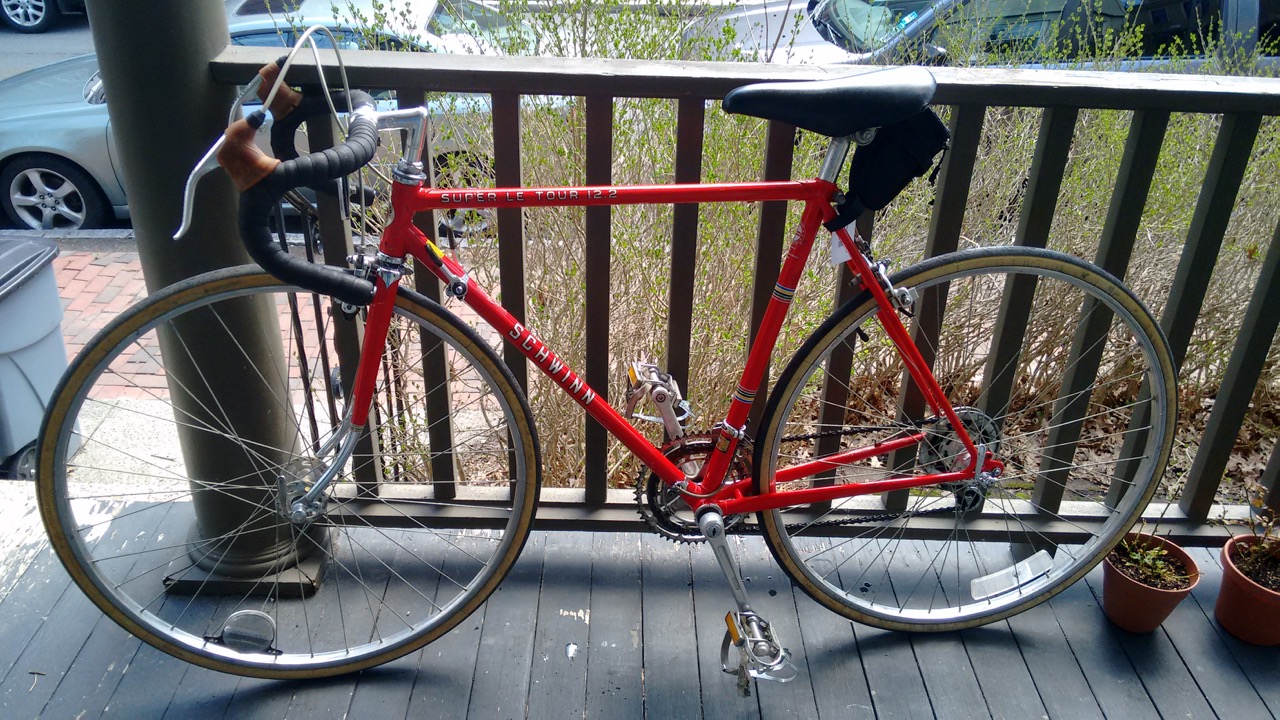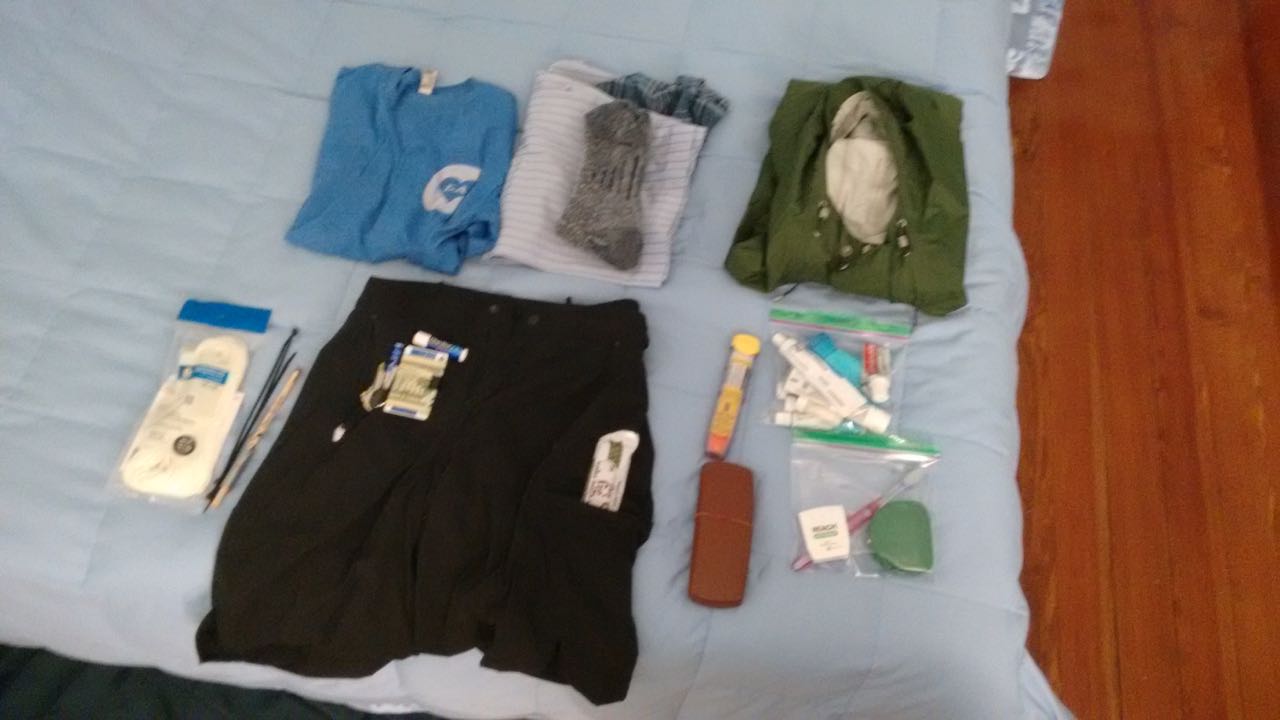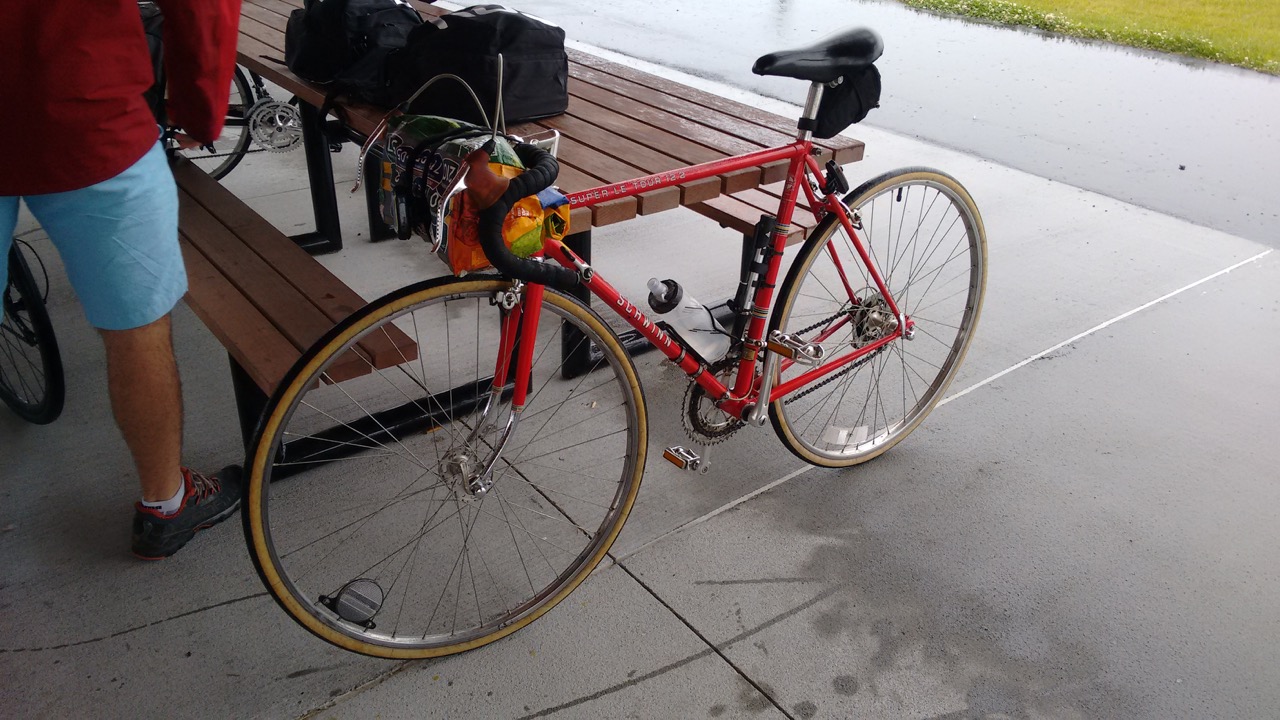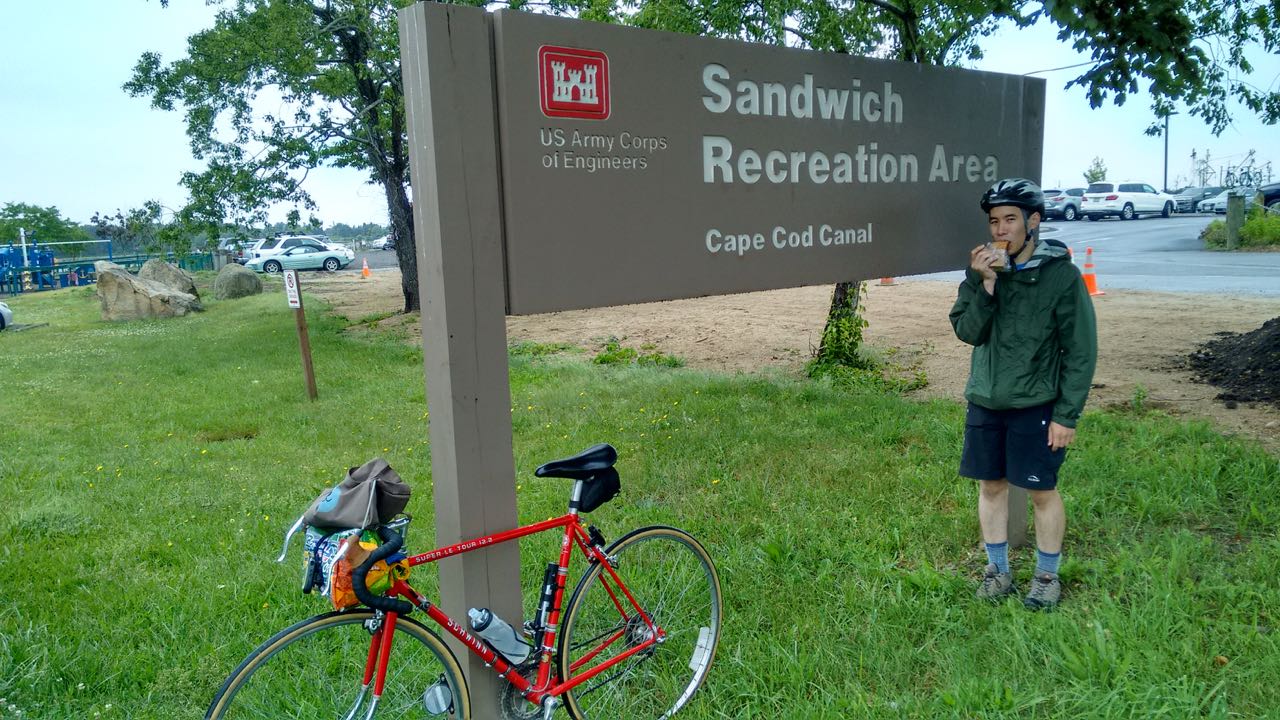Introduction
It was only after two years living in Cambridge, Mass. that I realized that bicycling is far and away the best way to get around, with walking a close second. So, in October 2016, I fetched myself a $55 light blue Schwinn Collegiate from the MIT Police Bike Auction. From a time when steel bikes were the only kind of bikes you could get, it weighs a hulking 40 pounds. But it’s essentially a bomb-proof fair-weather commuter bike. Slap on a rack and a crate and it’s been a reliable ferry of miscellany to and from my office for the last two years.
I’d had other ambitions, though, of longer bicycle touring adventures. Such ambitions began swelling even further as I found myself in possession of a 1977 Schwinn(-approved) Super Le Tour, which seems to have been kept in a shed for the last 40 years, as the Landry’s sticker (back from when it was called Landry’s Schwinn Cyclery) is still attached to it despite fraying at the edges.
We’d mused, Aaron, Matt, and I, about possible multi-day bicycle tours: the idea would be to hop on a bike, bike some 50 miles to a hotel or a campsite, overnight there, and continue on the next day, and repeat, until we get to a destination. We quickly settled on coastal routes, preferring rather level terrain and the irresistible sea breeze. The Super Le Tour would be perfect.

My Schwinn Super Le Tour. Also known as my baby.
We settled on a late-June date for a tour to Provincetown, MA. Located at the very tip of Cape Cod, it’s an excellent place to get away from the hustle and bustle of Boston, but still retain a very, very liberal and free-wheeling vibe. We would take the CapeFlyer weekend commuter train to Buzzards Bay, MA; bike to a hostel in Eastham, where we would pitch the night; then continue to Provincetown the following day, catching the last ferry back to Boston.
The Friday night before the trip, Aaron was to arrive at Boston’s South Station at about 10:30 PM. We could meet him at South Station, have a late dinner at Gourmet Dumpling House, and then head on back to the apartment to sleep. Since the train left at 8 AM, we needed to get up early. My alarm clock was set for 6 AM. However, Aaron’s bus came in late that evening, and transit back from South Station was not long, but it still did take some time. After all was said and done, I went to bed somewhere around 3 AM. And, to top it all off, I woke up around 5:30 AM, rather than 6 AM, in my excitement. So I ended up with just around two hours of sleep. And fifty miles of biking.
Gear
One of the reasons I wanted to write this blog post was to write about one of my most beloved adventures (of both “Type 1” and “Type 2” fun). But I also wanted to express some opinions about packing for bicycle touring. Here’s what I packed:

A very lightweight pack.
- Bicycle (1977 Schwinn Super Le Tour)
- Headlight and tail light (Serfas CP-R6 Quasar Combo)
- Portable pump (Topeak Mini Morph G without gauge)
- Bottle cage and water bottle (Camelbak Podium)
- Saddle pack:
- Spare tube
- Tire levers
- Patch kit
- Small Muji notebook and stubby pen
- Nitrile glove
- Tiny first-aid kit: bandages, alcohol prep pads
- Bicycle shorts (LL Bean):
- Phone
- Abbreviated wallet: credit card, debit card, health insurance, driver’s license, school ID, cash, postage stamps
- House keys
- Trader Joe’s “So a fig walks into a bar” cereal bar
- Chapstick
- The other clothes on my back: a t-shirt, socks, shoes, underwear
- A Trader Joe’s bag (Southern California version):
- Sandals
- Change of shirt, pajamas, socks
- Light raincoat (LL Bean)
- Tiny toiletry set: shampoo, conditioner, body wash, laundry detergent
- Toothpaste, toothbrush, lotion, sunblock, insect repellent, floss
- Glasses
- Zip-ties
- Duct tape wrapped around a pencil
- A length of thin rope
- Phone charger
You don’t need all this stuff. Sometimes I think that I need panniers, a front rack, a rear rack, a saddle bag, and a frame bag to carry everything. That’s probably true for the longer trips, but for a two-day trip as we did needs far fewer things.
Before I move onto advice for bringing things, there are a few essentials that I think are bare minimums for longish-distance touring that stops in cities along the way:
- Functioning bicycle, for obvious reasons.
- Repair kit that would be able to get you to the next town over should
you have mechanical issues with your bike. I’d say that the ability to tighten
loose hardware (bolts, nuts), repair a flat, and hold loose things in place
would be the bare minimum. I’ve been repeatedly impressed by the sheer lack
of things needed to get a bicycle moving, but I don’t want to imagine having
to walk my bike over to the next town. This means having:
- Spare inner tube and patch kit,
- Bicycle pump (I wouldn’t trust myself around CO2 cartridges),
- Tools required to service your bicycle: multitool, screwdrivers, wrenches, tire levers
- Water and food. On two separate occasions as a more novice rider I have experienced trouble with not having enough water or food.
- Helmet. I don’t let my friends ride without one.
- Front and rear lights. I’ve often ended up on rides where it’s suddenly dark (inclement weather, say) or that night fell faster than we expected. In this case, lights are essential for navigation. I personally call unlit bicycles at night “rolling metal death machines”.
- Means of contacting someone else in an emergency, like a cell phone.
- Cash and/or credit cards, to purchase what you might need along the way.
There are some things that I thought about when packing for the trip:
- You probably won’t need it.
- If you’re out for only two days, and you urgently need something, you might get by with just purchasing it on the way (this is the central tenet of “credit card touring”).
- You don’t need any fancy equipment on your bike. You can do as Aaron did and wear a backpack, do as I did and put it in my pockets, or do as Matt did and get a Planet Bike Eco Rack and strap on some panniers from Amazon on the back. Yes, the backpack can get sweaty, and I deliberately avoided bringing one. Between my bike shorts and my new bike jersey, I have eight pockets, of which six are zippered. My raincoat only added to that total.
- If you are traveling with others (you should! it’s so much more fun that way) then it’s possible your other friends might happen to have tire levers or a pump or a multi-tool. There was some discussion between the three of us to de-duplicate our packs.
- I really like ogling at the things at Velo-Orange and Ortlieb but it would be
a very expensive endeavor. I try to remember that there was life on the bicycle
before these kinds of companies, and try to imagine how people lashed things to
their bikes. I managed to find long (around 24” each) Velcro straps and this
reliably held my possessions firmly against the handlebars yet clear of my hands
when in any riding position.

My trusty steed, with Trader Joe's lashed to handlebars with Velcro straps.
- You probably won’t need it.
Saturday
Matt arrived on-time at 7 AM and so after I made my last adjustments to my pack, we pedaled off to South Station. I noticed my pack was swinging left and right, because it was, at that time, tied off with some rope. We made good time and arrived just about fifteen minutes before departure. Since we were only going to Buzzards Bay and not all the way to Hyannis, our one-way fare was just $20, and not the full $22, so we opted to pay aboard the train, whose conductors accepted cash.
As the lush green scenery rolled by, an enthusiastic conductor (who insisted the three of us were all “dudes”) collected our fare and continued towards the rear of the train. We also had some rather pricey Keurig coffee from the cafe car before arriving at our destination. As we pulled in closer to Buzzards Bay we noticed that it had started to rain – and not gently.
We collected ourselves in the shelter by the railroad depot, and figured out our day’s plans. First was lunch – we hadn’t really eaten much since we boarded the train, and we’d have a long day ahead. We settled on Leo’s Breakfast, a small diner before the bridge crossing over into the Cape proper. Breakfast is my favorite meal, and it did not disappoint. Factor in the price and it sealed the deal. In addition to monitoring the steady rainfall, we carefully watched our precious metal babies, locked outside to a flimsy railing. In the meantime, Aaron, who lacked a raincoat, went to the nearby sporting goods store to pick up a Frogg Togg.
Yeah, I went there.

Stopping in Barnstable for a short break.
Forgoing Chatham Lighthouse.
Striking a bright yellow concrete bollard while not paying attention.
Reaching Eastham.
Sir Cricket’s Fish & Chips.
The sunset at Rock Harbor Beach.
Sunday
Breakfast at the hostel.
Nauset Light.
Three Sisters.
The Flying Fish, in Wellfleet.
Assailed by a cloud of flying insects attracted to sunscreen.
Gospel Path & some steep hills.
Highland Light.
Reaching Provincetown.
Pilgrim Monument.
Province Lands.
Dinner at Tin Pan Alley.
Ice cream at Lewis Brothers.
Provincetown Ferry back to Boston.
Conclusions
Always stop for water and restroom breaks. You don’t know when the next one will come.
You can get away with packing not all that many things, although having friends helps.
Pack long in advance so you get some sleep the night before.
Charge your lights, so they don’t unexpectedly die en route. It’s sometimes hard to tell whether your rear light is still on!
It might be nice to have a cell phone holder to have the route on-hand. Paper maps also turn out to be indispensible – a small folded map that I periodically pulled out of my pocket while riding was just as useful and less energy-hungry than an always-on cell phone.